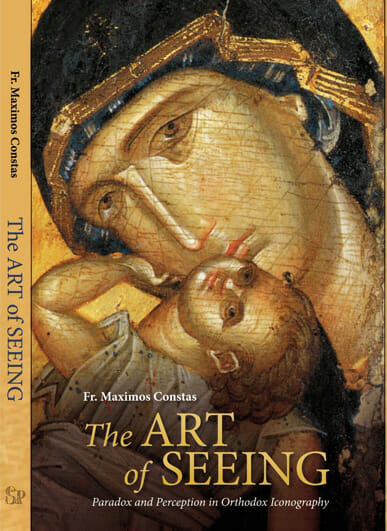Similar Posts
Fr. Maximos Constas, The Art of Seeing: Paradox and Perception in Orthodox Iconography. Alhambra, California: Sebastian Press, 2014. Pp. 263 + 73 color illustrations.
Many readers of the Orthodox Arts Journal have some familiarity with the concept of symbol. Reader’s of Fr. Silouan Justiniano’s articles, for example, will know that contributors to the journal wrestle with our culture’s functional denial of the icon’s essence because our culture no longer has a robust understanding of symbol.
If you would like to understand the concept of symbol through encounters with particular icons, Fr. Maximos’ book, The Art of Seeing, is a fantastic starting point.
Fr. Maximos rehabilitates the concept of symbol. In our secular culture most people conflate a “symbol” with a “sign.” So, all “icons” on our iPhones represent the app we use, or the pictogram of children crossing a road for us means “drive carefully.” Because Fr. Maximos assumes the icon is a symbol he gently leads the reader into sophisticated engagement with the icon. Using the same textual interpretation method of the church fathers for a written text Fr. Maximos transposes it for use in critiquing the visual icon.
In the western middle ages scholars read texts in four ways: historical, moral, allegorical and anagogic. In the east, Origen, the great Alexandrian theologian, used three categories of interpretation: historical or literal, typological and moral with the caveat that all three were really interdependent in practice. (Although Origen’s ideas were later deemed heretical, his interpretive method became the standard for patristic scholarship.) Despite some differences, until recently, both east and west agreed that to understand a text, one must acknowledge and explore that text on multiple levels.
Since the advent of modern literary criticism (and one could argue many other influences like Descartes, secularism, Darwin, Freud et al.) often, the only other level for reading a text besides the literal or historic is that of the “subtext” which has more to do with power, ego and the unconscious than with symbol. In The Art of Seeing, Fr. Maximos refreshingly reintroduces the ancient interpretative techniques for reading a text or in this case, an icon, and is thereby able to yank us out of the simplistic one dimensional morass of our modern world and lead us into a encounter with the icon as symbol.
Fr. Maximos writes clearly, coherently and with an easily identifiable framework, so The Art of Seeing is accessible for all types of readers without dumbing down or diminishing the subject. An example of this is when in analyzing the famous Sinai Christ icon, Fr. Maximos discusses “cerebral lateralization” as one way of exploring the well known difference in the two sides of Christ’s face. This is after a placid series of observations about the icon that a college student in a survey art class might make when “meeting” the icon for the first time.
The Art of Seeing is divided into four chapters with an introduction. Fr. Maximos explores the sixth-century Sinai Christ, icons of the Annunciation, icons of St. George and the meaning of the Iconostasis. In each chapter he locates the icons historically, explains the theological controversies of the time, looks at particular icons and discusses their aesthetic components finally weaving this all together with a discussion of the theological, spiritual implications for the viewer of the icon.
The first step in Fr. Maximos’ “reading” an icon is to be attentive. This is most difficult in our distracted age and requires some practice. Next we are to look at the icon as a truly historical form – which means understanding the context of the icon, the “living tradition of interpretation, within a community of faith and practice….”
In reading a text, church fathers looked for difficult passages that seem to contradict the obvious meaning of the passage, creating a stumbling block for the reader. Likewise, Fr. Maximos uses visual stumbling blocks to help the viewer go deeper into the icon’s meaning and leads us into the realm of symbol. Examples of visual disruption are the two sides of Christ’s face in the Sinai icon; the boyish, gentle face of the warrior in hard, angular armor; the Virgin spinning thread; the Iconostasis which simultaneously blocks vision and reveals truth – to “confront the reader with an unresolvable paradox and so drive the mind to the spiritual level on which such passages (images) have their proper resolution and meaning.” (pg. 21)
While looking for the areas of visual disruption, Fr. Maximos never denigrates the material as somehow “less authentic.” Instead, he celebrates the very matter, the pigments, the form of the icon for he says that these limitations “enable creation to share in the life of God.” Quoting Dionysios the Areopagite’s On the Celestial Hierarchy, Fr. Maximos explains how spiritual contemplation requires the use of visible, material symbols which are a type of veil. Veils “function as passages between two levels of experience.”
This is a correct understanding of symbol. This is a correct understanding of image. This is Orthodoxy and why the Church celebrates the restoration of icons on the Sunday of Orthodoxy, because in and through the icon, understood in the way Fr. Maximos explains, we find “healing for our damaged sensibility.”
Throughout The Art of Seeing, Fr. Maximos beckons the reader to leave this sallow world of bland virtual images and grab hold of the Real image and with this Real image, this new way of seeing, live our daily lives in the light of the Eighth day.
It is my hope that this is only the first of a series of books on icons by Fr. Maximos. Please buy this book and give it away. Give it to friends, family, priests and pastors, anyone who loves Orthodoxy and loves icons. In our world, we need more real icons and we need more books like The Art of Seeing.
The book is available from Sebastian Press http://www.westsrbdio.org/en/sebastian-press/item/292-the-art-of-seeing


One of the most spiritually encouraging and enlightening books I have ever read.